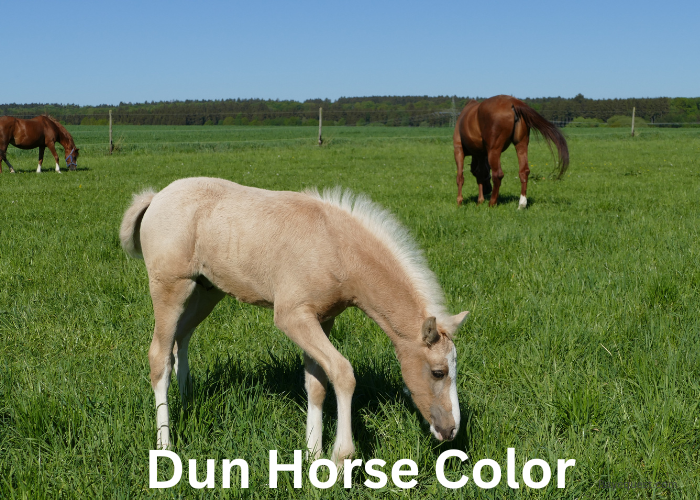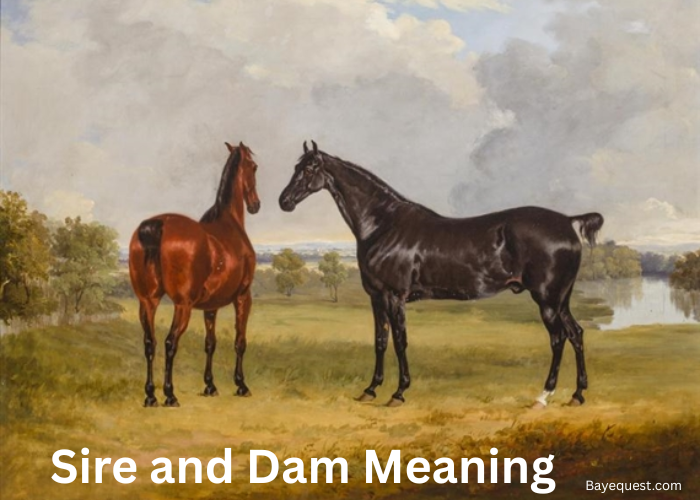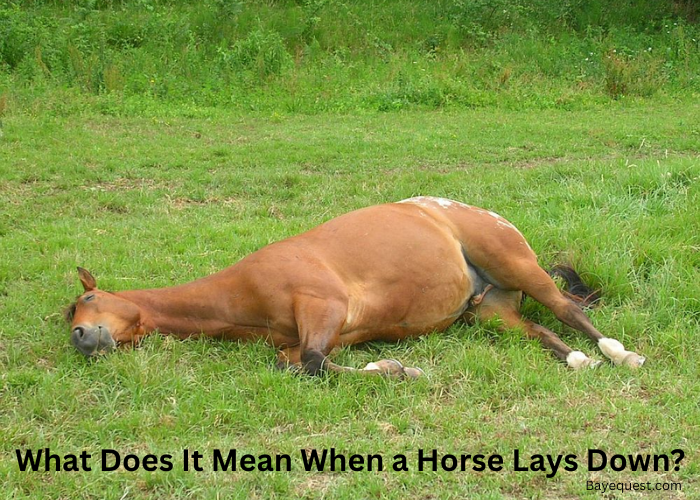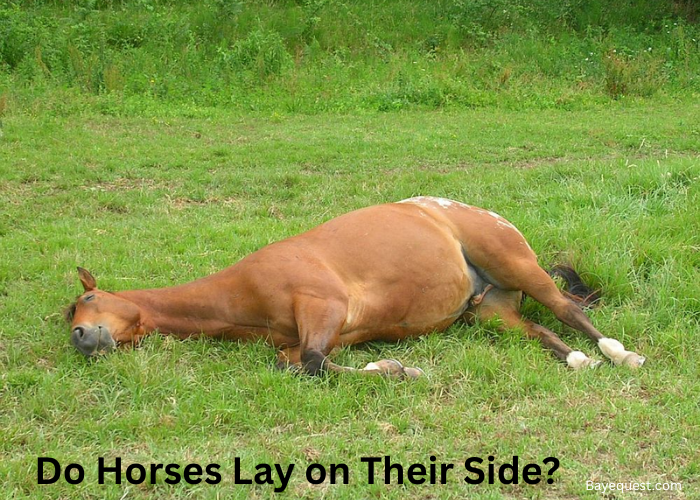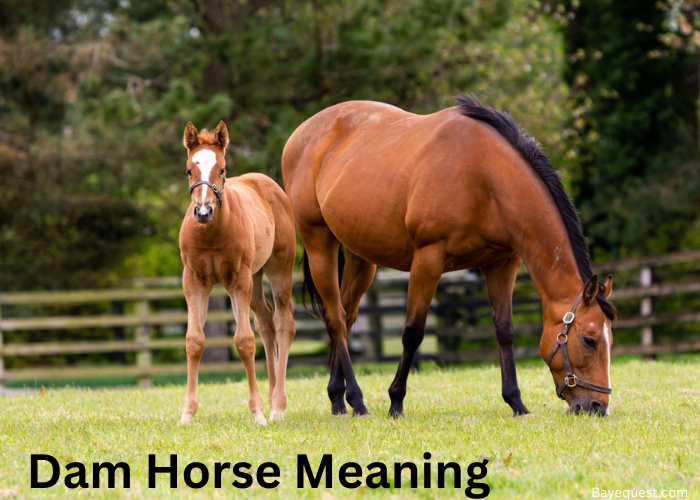Dun horses have a color that turns heads. Their soft, earthy tones and bold stripes make them easy to spot.
Some even have zebra-like markings on their legs. But their beauty isn’t just skin deep.
Behind that coat is a wild past and some cool genetics. That dark stripe down the back? It’s not just for looks, it tells a story.
Their color even helped them survive in the wild. There’s a lot more to dun horses than meets the eye.
Let’s take a closer look at what makes them so special.
Dun Horse Color: Key Takeaway
A dun horse has a unique coat with a lighter body and dark markings. Key features include a dorsal stripe, leg barring, and shoulder shadows. The dun gene lightens the base color while keeping these markings bold. Common variations are classic dun, red dun, and grullo, making them truly eye-catching.
What is a Dun Horse Color?
A dun horse color is a unique coat pattern caused by the dun dilution gene. This gene lightens the base coat color while leaving specific markings dark.
A classic dun horse has a yellowish or tan body with black or dark-colored mane, tail, and lower legs.
One of the defining features of a dun horse is the dorsal stripe, a dark line running down the spine.
Other distinctive markings include shoulder shadows and zebra-like stripes on the legs. These traits set dun horses apart from similar coat colors like buckskin.
The Genetics Behind the Dun Color
The dun color comes from a gene called the dun dilution gene. This gene affects the horse’s base coat color, making it lighter while keeping certain areas dark.
These darker areas include the mane, tail, dorsal stripe, and leg markings.
The gene works by reducing the pigment in the coat but leaves the pigment in specific regions unchanged.
It’s a dominant gene, which means a horse only needs one copy of the gene to show the dun color.
The dun gene interacts with the horse’s base coat:
- A bay base becomes a classic dun.
- A black base becomes a grullo or grulla.
- A chestnut base becomes a red dun.
This genetic mechanism makes the dun color unique and easily recognizable.
Characteristics of Dun Horses
Dun horses are known for their distinct and striking appearance. Here are the key features that set them apart:
1. Dorsal stripe. A dark stripe runs along the spine from the mane to the tail. This stripe is the hallmark of the dun coat.
2. Leg markings. Dun horses often have zebra-like stripes or barring on their legs, adding to their unique look.
3. Shoulder shadows. Some duns display a shadow or stripe across the shoulders, creating a subtle but noticeable marking.
4. Diluted body color. The body coat is lighter than the base color (e.g., yellowish-tan for classic dun, reddish for red dun, and grayish for grullo).
5. Dark points. The mane, tail, and lower legs are usually darker, contrasting with the lighter body.
Types of Dun Horse Colors
Dun horses come in several unique shades, each influenced by the horse’s base coat and the effects of the dun dilution gene.
Here are the most common types:
Classic Dun (Bay Dun)
The classic dun is the most recognized type. These horses have a golden or tan-colored body with dark points.
Their mane, tail, and lower legs are black, creating a sharp contrast against the lighter body.
A dark dorsal stripe runs down the back, accompanied by leg barring and subtle shoulder shadows that highlight their unique pattern.
Red Dun
Red duns have a warm reddish or coppery body tone.
Their mane and tail are usually lighter, often reddish or flaxen, complementing the body color.
The dorsal stripe and leg barring appear in a darker red shade, making them easy to identify.
Read also: Names of Red Colored Horses.
Grullo (Grulla Dun)
Grullo horses have a smoky or mouse-gray body with black points.
Their mane, tail, and lower legs are a deep black, while the dorsal stripe is bold and prominent.
Zebra-like stripes on the legs and shoulder shadows further enhance their striking appearance.
Black Dun (Raven Dun)
A black dun, also called a raven dun, is a less common but equally striking variation of the dun color.
It occurs when the dun dilution gene interacts with a solid black base coat, creating a lighter, smokier appearance while retaining the signature dun markings.
Its body appears a diluted black, often looking dark gray or charcoal.
Breeds Commonly Found with Dun Color
The dun coat color is seen across various horse breeds, with some being particularly known for this striking pattern.
These breeds carry the dun gene, making them natural carriers of this unique coloring.
Fjord Horse
Fjord horse breeds are almost always dun-colored, with shades ranging from classic dun to grullo.
Their characteristic black dorsal stripe is often flanked by lighter or darker shading, adding to their charm.
American Quarter Horse
The versatile American Quarter Horse often carries the dun gene.
Classic duns, red duns, and grullos are frequently seen within this breed, especially in working or western lines.
Icelandic Horse
Icelandic horses are known for their variety of coat colors, including dun. Grullo and red dun shades are particularly striking in this hardy breed.
Highland Pony
Native to Scotland, the Highland Pony often features dun colors. Their thick coats beautifully highlight the dorsal stripe and zebra-like leg markings.
Mustang
Mustangs, the iconic wild horses of North America, frequently exhibit dun coloring.
Their natural camouflage provided by the dun gene made them well-suited for survival in the wild.
Przewalski’s Horse
This ancient wild horse species from Asia is almost exclusively dun. Their sandy coats, bold dorsal stripe, and leg barring are defining characteristics of the breed.
How to Care for a Dun Horse
Caring for a dun horse is similar to caring for any horse. However, their lighter body color and unique markings may require some extra attention.
Here’s how to ensure your dun horse stays healthy and beautiful:
1. Protect their coat and skin
The lighter body color of some duns, especially red and classic duns, can make them more sensitive to sunburn.
- Use a fly sheet or sunscreen for horses during sunny months.
- Provide adequate shade in pastures to prevent overexposure to the sun.
2. Regular grooming
Dun horses have distinct markings, like dorsal stripes and leg barring, that are worth highlighting.
- Groom daily to keep their coat clean and free of dirt.
- Use a soft brush to enhance their natural shine and emphasize their markings.
3. Balanced nutrition
Good nutrition helps maintain the health of the coat and overall condition.
- Provide a diet rich in quality hay, grains, and supplements as needed.
- Ensure access to fresh water and monitor their weight to prevent obesity or malnourishment.
4. Maintain hoof health
Regular hoof care is essential for all horses, including duns.
- Schedule routine farrier visits for trimming or shoeing.
- Check for cracks, chips, or signs of thrush during grooming.
5. Monitor for skin conditions
Lighter-colored horses may show skin conditions more easily.
- Watch for signs of irritation, rashes, or fungal infections.
- Treat promptly with appropriate products or consult a vet if necessary.
6. Regular exercise and mental stimulation
Dun horses, like all breeds, need physical activity to stay fit and mentally engaged.
- Provide regular exercise tailored to their fitness level and breed.
- Spend time training or bonding to keep them mentally stimulated and content.
7. Seasonal care
Adjust care routines based on the weather and seasons.
- In winter, ensure they have adequate shelter and access to warm bedding.
- In summer, focus on hydration and protection from insects.
Common Myths About Dun Horses
Dun horses often captivate attention with their unique coat colors and markings, but there are many misconceptions about them.
Let’s debunk some of the most common myths:
1. All duns look the same
Many people believe all dun horses share the same shade. In reality, duns come in a variety of colors, including classic dun, red dun, grullo, and black dun.
Each type has unique characteristics based on the horse’s base coat color.
2. Dun and buckskin are the same
Dun and buckskin horses are often confused, but they are genetically different.
Buckskins are created by the cream dilution gene, not the dun gene, and lack the distinctive dorsal stripe and leg barring of duns.
3. All horses with a dorsal stripe are duns
Not all horses with a dorsal stripe are true duns.
Some horses, like bay or chestnut, can develop countershading, which mimics a dorsal stripe but lacks the other defining dun features like leg barring and shoulder shadows.
4. Duns are only found in certain breeds
While some breeds are more likely to carry the dun gene, such as Fjords and Mustangs, dun coloration can occur in many breeds.
5. Dun horses are always wild horses
This myth likely stems from the common dun coloring in wild horses like Mustangs and Przewalski’s Horses.
While duns are common in wild herds, domestic breeds can also exhibit this color.
6. Dun horses are harder to train
Some believe dun horses are stubborn or difficult to train because they are associated with wild traits.
In truth, temperament is not determined by coat color but by breed, training, and individual personality.
Dun Vs Buckskin
Dun and buckskin horses may look alike, but they are very different.
The dun color is caused by the dun dilution gene. This gene lightens the horse’s body but leaves dark markings.
These markings include a dorsal stripe, leg barring, and shoulder shadows.
Buckskins, however, are created by the cream dilution gene. This gene lightens a bay base coat to a golden or tan shade.
Unlike duns, buckskins do not have primitive markings. A dun horse’s markings are bold and distinctive, while buckskins have a smooth and uniform coat.
Classic duns often have a yellowish tone, while buckskins have a shinier golden hue.
Both colors are beautiful but easy to tell apart once you know what to look for.
If you see a horse with a dorsal stripe and leg bars, it’s a dun. A solid golden coat with dark points is a buckskin.
Dunskin Horse Color: Conclusion
Dun horses are truly one of a kind. Their unique colors and primitive markings make them stand out in any herd.
Whether it’s the bold dorsal stripe or the zebra-like leg bars, every dun tells a story of nature’s artistry.
From classic dun to grullo, these horses are as diverse as they are stunning.
Understanding their genetics and characteristics only deepens your appreciation for them.
Next time you see a dun horse, take a moment to admire its beauty. These horses are a living example of nature’s perfect design.




